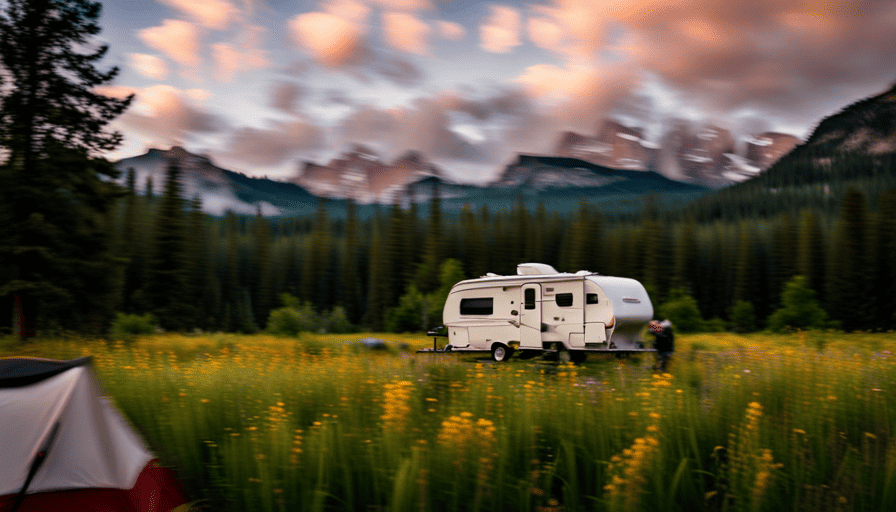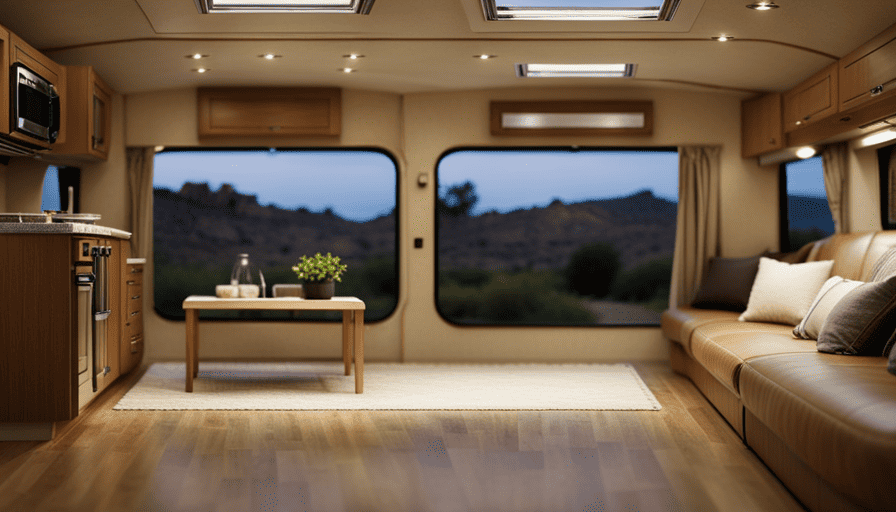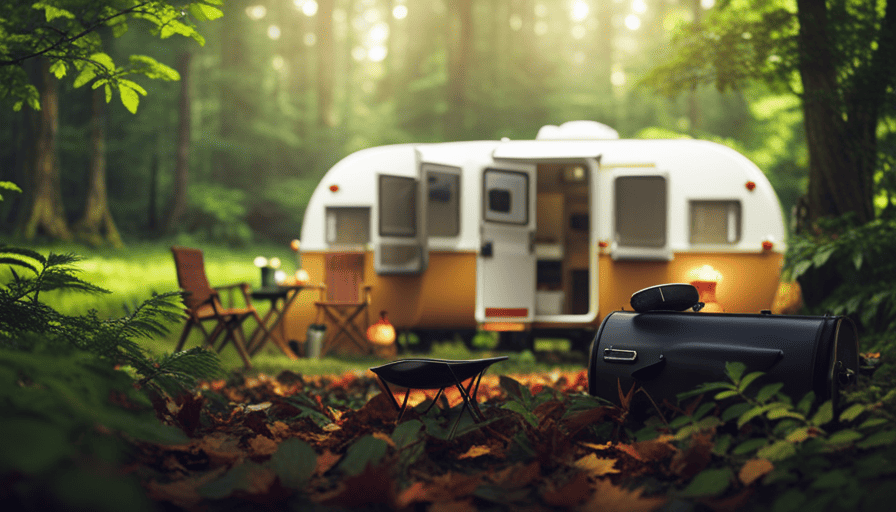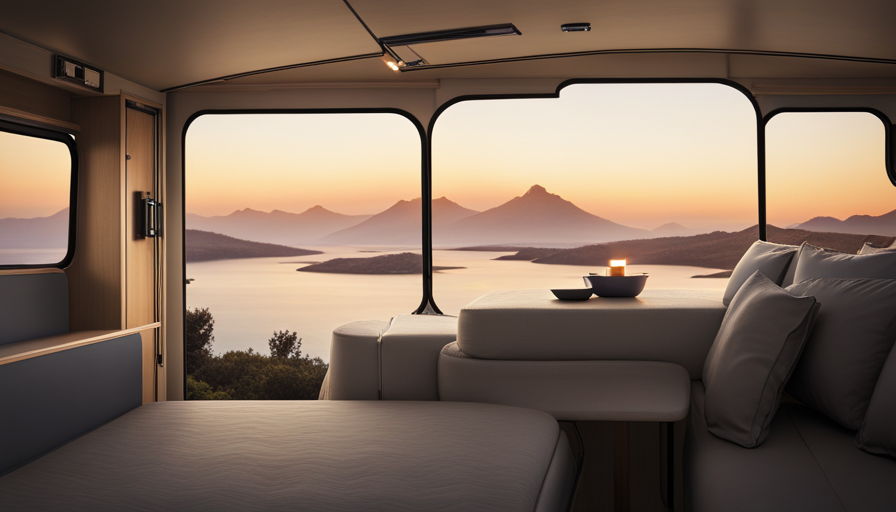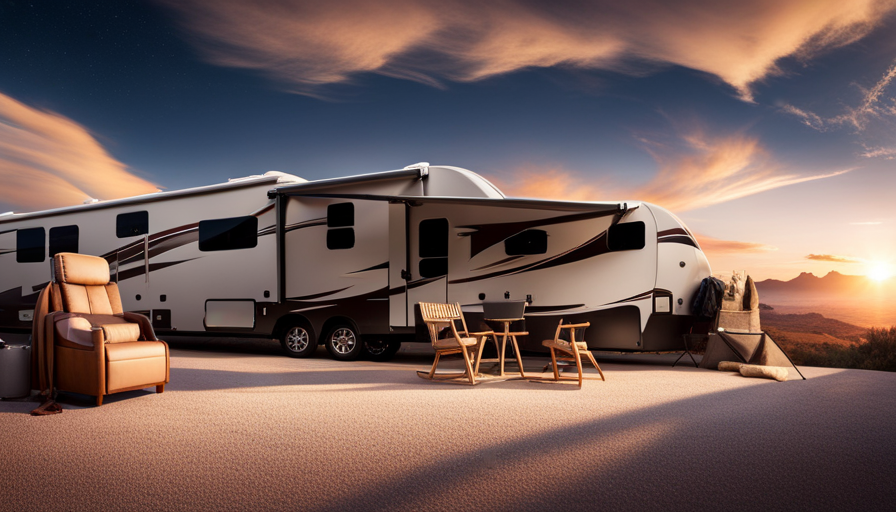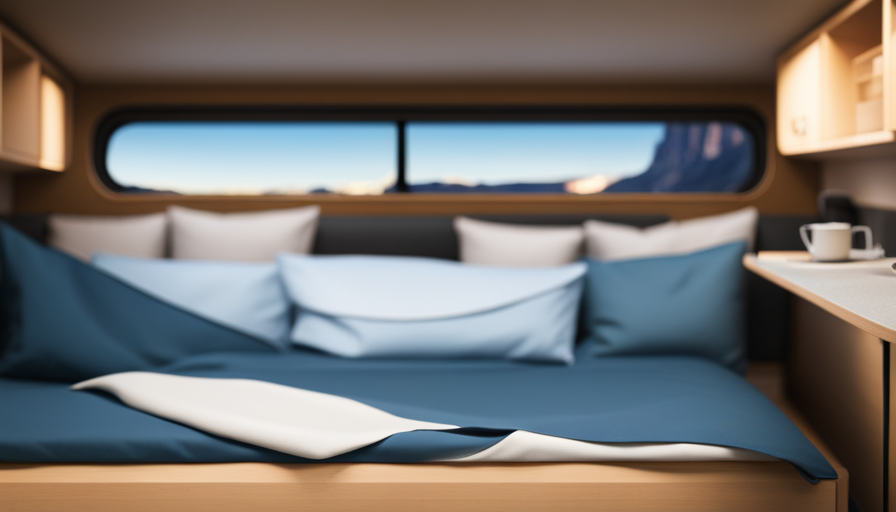Excited to explore the open road and immerse yourself in nature? Before you set out on your upcoming camping journey, it’s essential to prepare your camper for the season by de-winterizing it.
This process ensures that your vehicle is in tip-top shape and ready for the upcoming camping season. From draining and flushing the water system to inspecting and cleaning appliances, there are several essential steps to take.
Don’t forget to check and replace any damaged seals, refill propane tanks, and test and recharge the battery. Additionally, it’s important to examine the tires for any signs of wear and tear and stock up on essential supplies.
With these expert tips and tricks, you’ll be well-prepared to enjoy a seamless and enjoyable camping experience. So, let’s dive into the de-winterization process and get your camper ready for adventure!
Key Takeaways
- Drain and flush water system for clean and safe water
- Sanitize water tanks with bleach solution
- Refill propane tanks and recharge battery
- Check and replace damaged seals
Drain and flush the water system
To properly de-winterize your camper, you’ll need to drain and flush the water system. This is an essential step to ensure that your water is clean and safe for use.
Start by flushing and sanitizing the water tanks. To do this, open the drain valves and let all the water out. Next, mix a solution of water and bleach, and pour it into the fresh water tank. Run the water pump until you can smell the bleach in the water. Let it sit for a few hours or overnight, and then drain and flush the tanks again.
After sanitizing the tanks, it’s important to test and clean the water heater. Turn off the power to the water heater and drain it completely. Check the anode rod for any signs of corrosion and replace it if necessary. Once the tank is empty, close the drain valve and refill it with water. Turn on the power and let the water heater run for a few minutes to ensure it’s working properly.
With the water system taken care of, it’s time to check and clean the exterior of the camper. This will ensure that your camper is in good condition and ready for your next adventure.
Check and clean the exterior of the camper
First, take a walk around your cozy home on wheels, scanning for any signs of dirt or grime that may have accumulated during the winter months. Keeping the exterior of your camper clean not only enhances its appearance but also prevents potential damage. Here are three cleaning methods to keep your camper looking fresh and protected:
-
Start by washing the exterior with a mild soap and water solution. Use a soft sponge or brush to gently scrub away any dirt or debris. Pay special attention to the windows, awnings, and any other areas that may have collected dirt.
-
After washing, apply a protective wax or sealant to the exterior. This will help to protect the camper from UV rays, oxidation, and other environmental factors. Be sure to follow the manufacturer’s instructions for application.
-
Regularly clean and inspect the roof of your camper to prevent leaks and water damage. Remove any leaves, branches, or other debris that may have accumulated. Consider using a rubber roof cleaner and conditioner to maintain its longevity.
Regularly cleaning and maintaining the exterior of your camper is essential for its longevity and overall appearance. Once the exterior is clean and protected, it’s time to move on to the next step: inspect and clean the appliances.
Inspect and clean the appliances
Next up, take a moment to inspect and give your appliances a good cleaning to ensure they’re in tip-top shape for your adventures ahead!
Start by inspecting each appliance carefully. Check for any visible signs of damage or wear, such as rust, cracks, or loose connections. Pay special attention to the refrigerator, stove, and water heater, as they’re often the most heavily used.
Once you’ve completed the inspection, it’s time to give your appliances a thorough cleaning. Start by removing any dirt or debris from the exterior surfaces using a mild detergent and a soft cloth. Be sure to clean all the nooks and crannies, paying extra attention to the ventilation areas.
Next, move on to the interior of each appliance. Remove any removable parts, such as shelves or burners, and clean them separately using warm soapy water. Use a toothbrush or a small brush to scrub away any stubborn stains or build-up.
After cleaning, carefully reassemble all the parts and make sure everything’s back in its proper place. Finally, wipe down the exterior surfaces once more to remove any cleaning residue.
With your appliances thoroughly inspected and cleaned, it’s time to move on to the next step: testing the electrical system.
Test the electrical system
Now it’s time to ensure that your electrical system is in proper working order for your upcoming adventures. The electrical system in your camper is crucial for powering appliances, lights, and other electrical components. Before hitting the road, it’s important to test the system and address any common electrical issues that may arise.
To begin, let’s discuss some common electrical issues you may encounter. These can include blown fuses, tripped circuit breakers, faulty outlets, or even damaged wiring. By familiarizing yourself with these potential problems, you’ll be better equipped to troubleshoot and resolve them.
To test the electrical system, it’s essential to take safety precautions. Always turn off the power supply before inspecting or working on any electrical components. Use a multimeter to check for proper voltage and continuity in the wiring. Ensure that all outlets, switches, and appliances are functioning correctly.
To engage you further, here’s a helpful table summarizing the steps to test the electrical system:
| Step | Procedure | Result |
|---|---|---|
| 1 | Turn off power supply | Safe working environment |
| 2 | Use multimeter to check voltage | Proper electrical flow |
| 3 | Test outlets, switches, and appliances | Functioning components |
By following these steps, you can identify and address any electrical issues with confidence. Once you have tested the electrical system, it’s time to move on to the next section and check and replace any damaged or worn-out seals. This ensures that your camper remains weatherproof and ready for your adventures.
Check and replace any damaged or worn-out seals
Ensuring the integrity of the protective barriers in your mobile home is crucial for maintaining its weather resistance and safeguarding against potential water damage. As you de-winterize your camper, it’s essential to thoroughly inspect and replace any damaged or worn-out seals.
Here are some key steps to follow during the seal inspection and replacement process:
- Carefully examine all exterior seams, windows, doors, and vents for signs of wear or damage.
- Check for cracks, gaps, or missing sections in the seals.
- Use a sealant or caulk to repair minor cracks or gaps.
- For more severe damage, such as torn or deteriorated seals, it’s advisable to replace them completely.
- Ensure that the new seals are properly aligned and securely fastened.
Inspecting and replacing the seals is vital to prevent water leakage and maintain the overall structural integrity of your camper. Neglecting this step could lead to costly repairs and potential water damage down the line.
After completing the seal inspection and replacement, the next section will focus on inspecting and cleaning the plumbing system.
Inspect and clean the plumbing system
Once you’ve checked and replaced any damaged seals, it’s time to inspect and clean your plumbing system to ensure it’s properly functioning. This step is crucial to prevent any leaks or water damage during your camping trips.
To start, inspect the water lines for any signs of cracks or leaks. Look closely at the connections and fittings as well. If you notice any issues, make sure to repair or replace them before using the camper.
Next, it’s important to clean the water heater. Over time, sediment and mineral deposits can build up inside, affecting its efficiency. Start by turning off the power and water supply to the heater. Drain the tank completely and remove any debris or sediment that may have accumulated. You can use a hose to flush out the tank and remove any remaining residue. Once cleaned, refill the tank and turn the power and water supply back on.
With the plumbing system inspected and cleaned, it’s time to move on to the next step: checking and refilling the propane tanks.
Check and refill propane tanks
To keep your camping trips running smoothly, don’t forget to check and refill the propane tanks. Propane is an essential resource for your camper, providing heat for cooking, hot water, and even powering your refrigerator. However, it’s important to prioritize propane safety and perform regular propane tank maintenance.
Start by visually inspecting the propane tanks for any signs of damage or rust. Look for any leaks or loose connections. If you notice any issues, it’s best to have a professional inspect and repair them before refilling the tanks.
Next, turn off all appliances that use propane and close the main valve on the propane tank. Disconnect the tank from the camper and carefully transport it to a certified propane refill station. Ensure that the tank is securely fastened during transportation to prevent any accidents.
At the refill station, have the tanks inspected for any potential issues and then proceed with refilling them. Follow the instructions provided by the refill station attendant and make sure to tighten all connections properly.
Once the tanks are refilled, reconnect them to your camper, ensuring that all connections are secure and leak-free. Open the main valve on the propane tank and check for any leaks using a soapy water solution. If no leaks are detected, you can proceed to test and recharge the battery for your camper.
Transition: Now that the propane tanks are filled and ready to go, it’s time to shift our focus to testing and recharging the battery.
Test and recharge the battery
Now that the propane tanks are filled and good to go, let’s make sure the battery is charged and ready for your camping adventures.
The battery is a crucial component of your camper, providing power for lights, appliances, and other electrical systems. To ensure it’s in optimal condition, follow these steps:
- Start by disconnecting the battery from any power source and removing it from its storage compartment.
- Inspect the battery for any signs of damage or corrosion. If you notice any, it may need to be replaced.
- Clean the battery terminals using a wire brush and a mixture of baking soda and water. This will help ensure a good connection.
- Reconnect the battery and test its voltage using a multimeter. A healthy battery should read around 12.6 volts or higher.
If you encounter any electrical issues or the battery fails the voltage test, it may be time to replace it. Consider investing in a deep-cycle battery, specifically designed for camping purposes, as they provide a longer lifespan and better performance.
With the battery taken care of, let’s move on to the next step: checking and replacing any damaged or worn-out tires.
Check and replace any damaged or worn-out tires
Make sure you take a moment to inspect your camper’s tires for any signs of damage or wear and replace them if necessary. Proper tire maintenance is crucial for the safety and performance of your camper.
Start by checking the tread depth using a tread depth gauge. If the tread depth is less than 4/32 of an inch, it’s time to replace the tires. Additionally, look for any cracks or bulges on the sidewalls, as these could indicate tire damage. If you notice any of these issues, it’s best to replace the tire immediately.
When replacing the tires, make sure to choose ones that are appropriate for your camper’s weight and load capacity. Check the manufacturer’s specifications for the recommended tire size and load rating. It’s also a good idea to invest in a quality tire pressure gauge and regularly check the tire pressure. Underinflated tires can lead to poor fuel efficiency and increased risk of a blowout.
With your camper’s tires in good condition, you can now transition into the next step of preparing for the camping season: stocking up on essential supplies.
Stock up on essential supplies for the camping season
Get ready for the camping season by stocking up on essential supplies, like a bear to honey, to ensure a smooth and enjoyable outdoor experience. As an experienced camper, I know the importance of having the right gear and accessories to make the most of my time in nature. Here are five must-have items that will enhance your camping trip:
-
Camping gear essentials: What to stock up on for a hassle-free trip:
-
Tent: Invest in a reliable, spacious tent that can withstand various weather conditions. Look for one with easy setup and durable material.
-
Sleeping bag: Choose a sleeping bag that suits the temperature range of your camping destination. Opt for one that is lightweight and easy to pack.
-
Camping stove: A portable camping stove will allow you to cook delicious meals outdoors. Look for one that is compact, easy to use, and has multiple burners.
-
Water filter: Ensure a safe and clean water supply by packing a reliable water filter. This will come in handy when hiking or camping near natural water sources.
-
Lighting: Don’t forget to pack a reliable source of lighting, such as a lantern or headlamp. This will provide illumination during nighttime activities and emergencies.
By stocking up on these essential supplies, you’ll be well-prepared for your camping adventures and create lasting memories in the great outdoors.
Frequently Asked Questions
How do I properly drain and flush the water system in my camper?
To properly drain and flush the water system in my camper, I follow a simple maintenance routine. First, I turn off the water supply and open all faucets to release any remaining water.
Then, I locate the drain valve and attach a hose to it, allowing the water to flow out.
After draining, I fill the system with a mixture of water and sterilization solution, let it sit for a few minutes, and then flush it out thoroughly.
This ensures a clean and sanitized water system for my camper.
What are some tips for checking and cleaning the exterior of my camper?
When it comes to checking and cleaning the exterior of your camper, there are a few key things to keep in mind. First, always start by inspecting for any leaks or damage. For example, I’ve once had a camper with a small crack on the roof that was causing water to seep in.
Additionally, be sure to remove any mold or mildew that may have developed during the winter months. Regularly cleaning and maintaining the exterior of your camper will help prolong its lifespan and ensure a safe and enjoyable camping experience.
How do I inspect and clean the appliances in my camper?
To inspect and clean the refrigerator in your camper, start by checking the seals for any cracks or gaps. Clean the interior with a mixture of warm water and mild detergent, then wipe it dry.
For the stove, inspect the burners for any clogs or damage. Clean them with a brush or cloth, removing any food debris.
To troubleshoot and maintain the stove, test the ignition system and ensure the gas lines are secure. Regularly clean the stove to prevent grease buildup and maintain its efficiency.
What steps should I take to test the electrical system in my camper?
To test the electrical system in my camper, I start by ensuring that the power source is connected properly.
Then, I check all the fuses and breakers to make sure they’re in working order.
Next, I use a voltage tester to check the outlets and make sure they’re receiving power.
If I encounter any issues, I proceed with troubleshooting power issues by inspecting the wiring and connections for any damage or loose connections.
How do I check and replace damaged or worn-out seals in my camper?
Imagine your camper as a sturdy ship sailing through the wilderness. Just like a ship, it’s essential to regularly inspect and maintain the seals to keep the elements at bay.
To check the seals, carefully examine the windows, doors, and roof vents for any signs of damage or wear. If you spot any issues, it’s time to replace them.
Ensure you choose high-quality seals that fit perfectly to keep your camper watertight and cozy.
How Can I Fix a Camper Slide Out That Is Not Working After Winterization?
If you’re facing issues with your camper slide out after winterization, here are some helpful camper slide out troubleshooting tips. Firstly, check for any obstructions or debris that may be preventing smooth movement. Additionally, ensure the power source is connected and functioning properly. Lubricating the slide-out mechanism can also help alleviate any potential problems. Remember to follow safety guidelines and refer to your specific camper’s manual for detailed instructions.
Conclusion
In conclusion, de-winterizing your camper is a crucial step to ensure a smooth and enjoyable camping season.
By draining and flushing the water system, checking and cleaning the exterior, inspecting and cleaning the appliances, testing the electrical system, checking and replacing damaged seals, refilling propane tanks, testing and recharging the battery, and checking and replacing worn-out tires, you’ll have a camper that’s ready to hit the road.
Don’t forget to stock up on essential supplies to make your camping experience even better. Happy camping!

